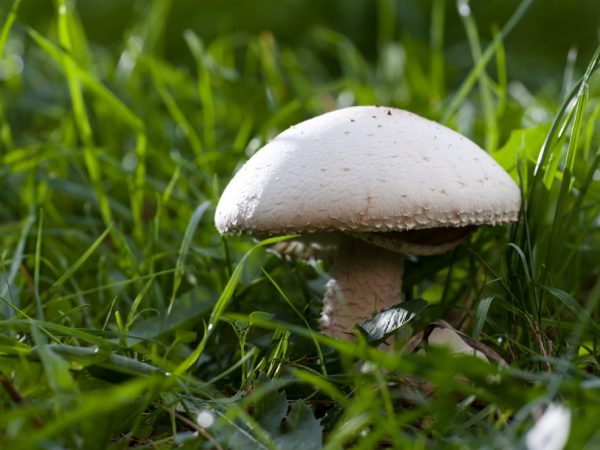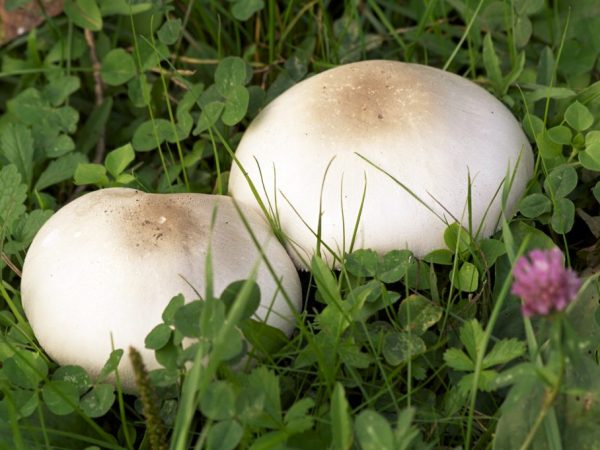Field champignon
Field champignon is a member of the Agaricaceae or Champignon mushroom family of the Champignon genus. It has specific synonyms, which are also often and in parallel used when talking about this type of mushroom: common champignon and sidewalk. In English, its name sounds like "horse mushroom" (Horse mushroom), since it often grows near stables on a soil well fertilized with manure.

Field champignon
Botanical characteristic
The first description of Agaricus arvensis, or field mushroom, was carried out in 1762 by the German mycologist Jacob Schaeffer.
For the field champignon, according to the description, it is characteristic that the fruit body is large enough. In a thick-fleshed cap, over time (from the moment of the onset of development to full maturation), the shape changes:
- initially it is bell-shaped, rounded, the edges are wrapped inward, a private veil hides the plates of the hymenophore;
- in adult mushrooms, the cap is flat or prostrate-convex, with a small tubercle located in its central part, and smooth or wavy edges; under the cap there is a two-layer hanging ring left after the rupture of a dense veil.
The diameter of the cap is within 8-20 cm (but more often 5-15 cm), the color of the surface is cream or white, after a while the color becomes ocher. The surface of the mushroom cap is smooth, silky, or it can be covered with fibrous scales of yellow or brown shades.
The mushroom pulp is dense and softens over time. Field champignon has a sweetish taste and a characteristic anise or almond smell, especially concentrated (saturated) in young mushrooms. The color of the flesh is white, over time it becomes slightly yellowish. May give slight yellowing at the fracture.
With age, the surface of the cap is capable of acquiring (albeit slowly) a yellow color at the point of contact.
The pulp of the mushroom when interacting with caustic potassium, or potassium hydroxide (KOH) to give the so-called. color chemical reaction - to turn yellow.
Mushroom plates are often planted, swollen, 8-12 mm wide. Initially (in young mushrooms) they are colored white or white-gray, then they become pale pink, brown and mustard, practically black.
The leg grows 6-10 cm in height, 1-1.5 cm in width, has a cylindrical shape, thickens towards the base, there is a flocculent plaque at its base. A large white two-layer ring is present on the pedicle, while the lower annular layer is shorter and has a yellow, serrated edge. The mushroom leg is easily detachable from the cap; during mechanical action, it changes its color to yellow.
Similar related varieties
The external description of the field champignon is similar to other twin mushrooms, which include:
- Death cap: has white plates of the hymenophore, a pronounced tuberous swelling of the base of the mushroom leg, which in turn is covered with volva - the remainder of the general velum (bedspread) and a single-layer ring very close to the bottom of the cap.The pale toadstool lacks the aniseed or nutty aroma characteristic of the field mushroom. For your information. It is possible to confuse these two species only if the pale grebe is a young specimen.
- Champignon yellow-skinned (red): related. but somewhat smaller in size is a species from the same Champignon family and the Champignon genus, often found in July-October among the plantings of white acacia. It has a peculiar "pharmacy" smell of carbolic acid, its pulp immediately turns yellow when the cap edge and base are broken.
A lot of poisoning occurs due to the fact that field mushroom is very often confused with white amanita. This is especially dangerous if you are faced with young specimens in which the hymenophore plates have not yet changed their color (turned pink or brown).

Study the description of the mushroom carefully
The field champignon has similarities with edible species from its genus, from which it differs in larger sizes. The most similar counterpart is the curve champignon species, which grows in darkened spruce forests.
Geography of distribution
Field champignon is a saprotroph, those. an organism settling on the decaying remains of living organisms and destroying them to the simplest mineral and organic compounds. The main places of growth are open soils overgrown with grass, including meadows and forest clearings, roadside, forest clearings, garden and park areas, a little less often - pasture areas. The fungus grows equally on plains and mountainous areas, flavored with organic remains, singly or in groups formed in the form of an arc or ring.
The growing and harvesting season is the last days of May to mid-November.
More often it is possible to meet near places where nettles grow, less often near trees, with the exception of conifers. The geography of distribution covers all Russian regions, but especially often the mushroom is found in the regions of the northern temperate latitudes.
Practical use
Field champignon is an edible mushroom, and not only after heat treatment, but also raw. According to its taste, it belongs to category 3. It is considered a delicious gourmet product. Suitable for pickling and salting, frying and stewing.
Irina Selyutina (Biologist):
Field champignon, like other types of this useful mushroom, has found its application in cosmetology to eliminate all sorts of problems of the skin of the face. It is used as part of masks:
- Skin nutrition and hydration: raw champignon, thoroughly washed and crushed into gruel, is mixed with 1 tbsp. spoon of vegetable oil (linseed, sunflower, olive) and applied to the skin for 15 minutes 2 times a week. The mask is washed off with warm water.
- Oily skin care: the crushed peel of 2 champignons is mixed with 30 ml of low-fat kefir or yogurt and applied for 20 minutes 2 times a week. Wash off with warm water. Advice. If there are age spots on the face, you can add a few drops of lemon juice to the main composition.
- Sensitive skin care: 2 mushrooms are crushed into gruel and mixed with a tablespoon of fat sour cream. Apply the mask for 20 minutes. Wash off with warm water. Experts recommend carrying out this procedure once every 3 days.
- Problem skin care (acne, acne): chop fresh champignons and squeeze the juice through cheesecloth. Use juice to rub the skin. Attention! The amount of juice should correspond to one procedure - it is not recommended to leave the solution overnight, even in the refrigerator, because the necessary substances are being destroyed.
Consider. Before carrying out cosmetic procedures at home, make sure that you do not have an allergic reaction to the components of the fungus. To do this, apply a small amount of the mass to the bend of the arm near the elbow: if allergic rashes, irritation appear, wash off the composition.
Advice. If there are no fresh mushrooms, use mushroom powder.
For all its useful qualities, it is capable of:
- accumulate in the fruit body heavy metals, including cadmium and copper, which are potentially dangerous substances for human health;
- provoke gastrointestinal problems when overeating.
Conclusion
Field champignon is one of the edible mushrooms. It has good gastronomic qualities. Suitable for many dishes, let us eat fresh. Grows throughout Russia in open areas.



